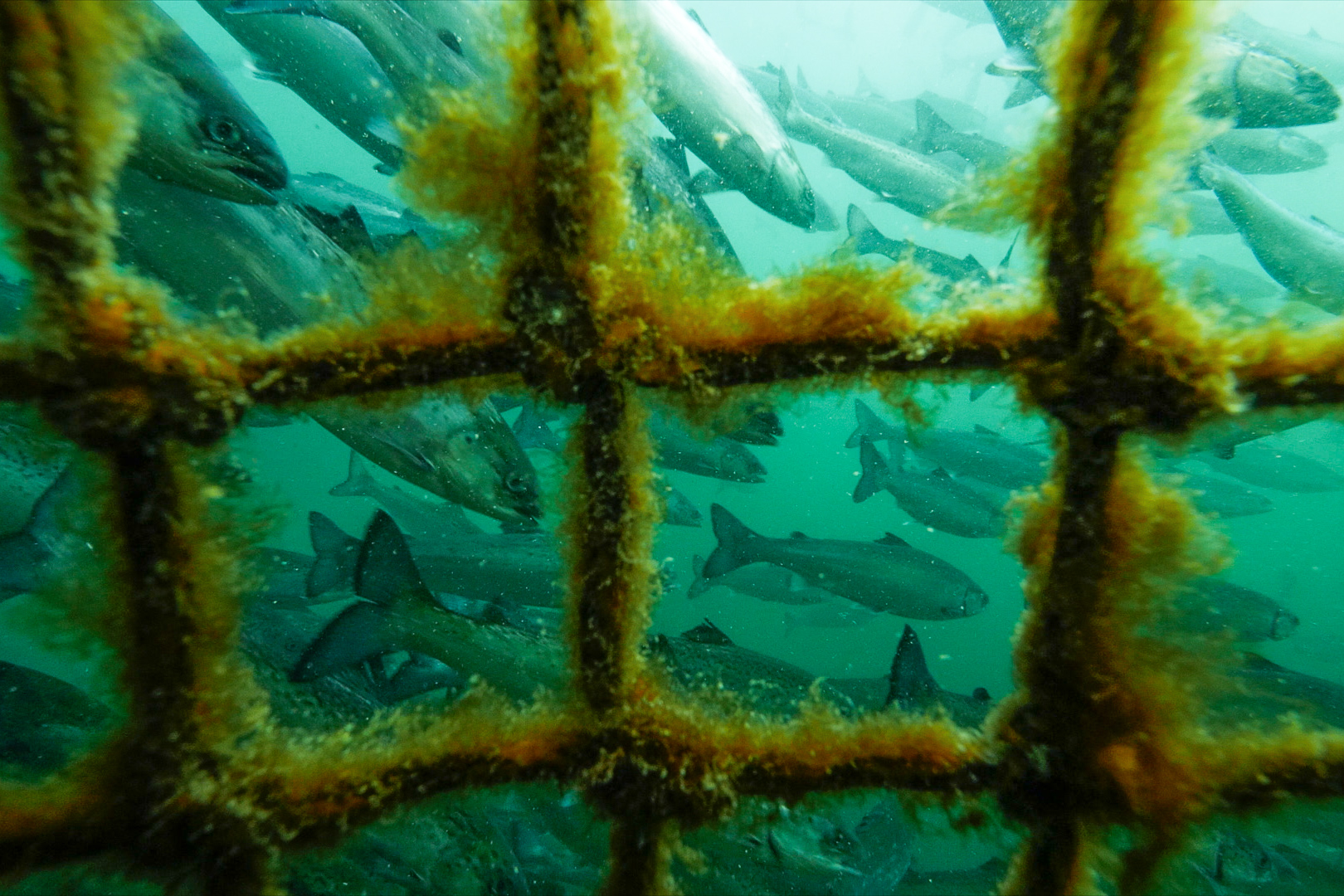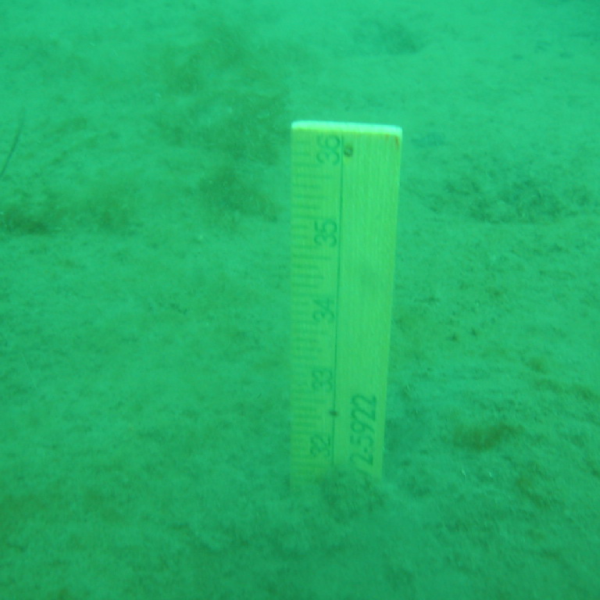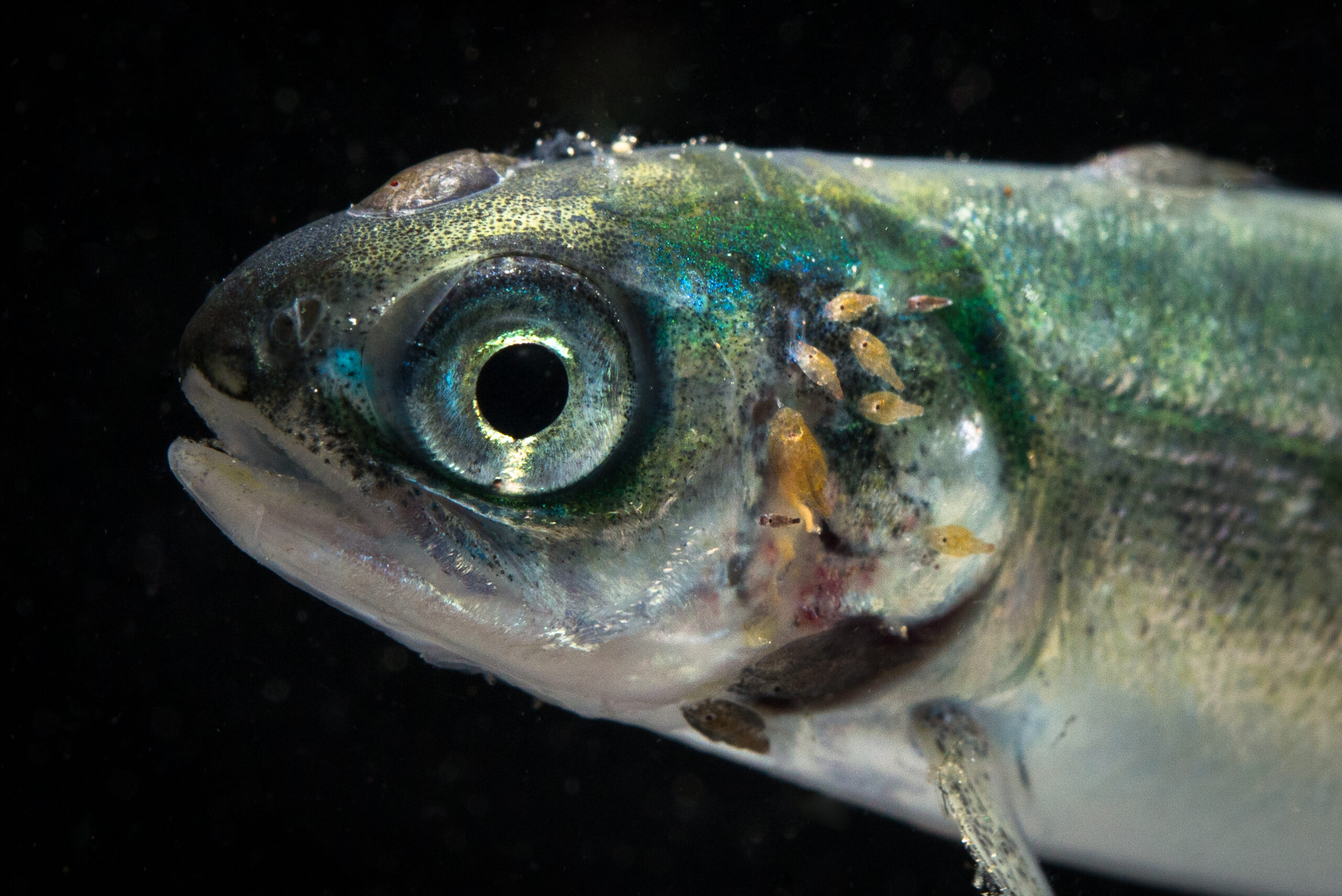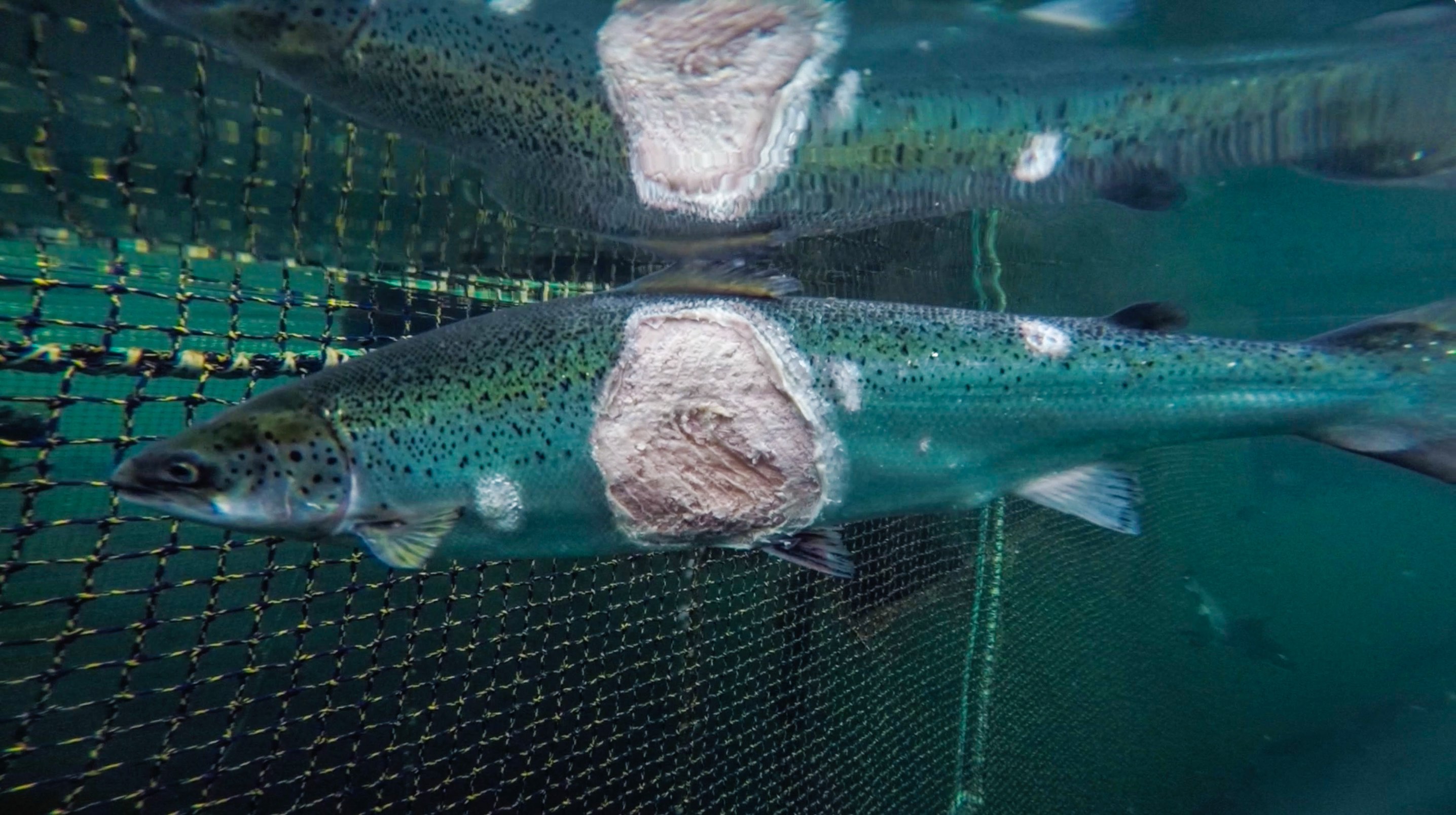Get the facts

Copyright Tavish Campbell
The overview
Salmon raised in open-net pens typically spend 12-22 months trapped in sea cages or net-pens made of plastic mesh, suspended from a floating platform, a short distance from the shoreline. Farm footprints vary, with net-pen depths in the 30-50-meter range and dimensions ranging from 30-100 meters. A farm may contain as many as 16 pens, each one holding 100,000 salmon or more.
The plastic mesh allows excrement and excess feed to flow freely into the surrounding ocean environment. The farms operate as open sewers, depending on tides and currents to flush the waste away. The ocean floor surrounding the pens suffocates under a thick layer of feces, feed and dead fish. The feed may be laced with drugs used to fight disease and the voracious parasites that devour the salmon’s skin. The toxic stew emanating from the farms contains viruses, bacteria and parasites capable of infecting juvenile salmon and other organisms. Drug residue may be lethal to some also.
Farmed salmon are fed dry pellets, made from vegetables, such as soy, animal waste and fish meal. That meal comes from wild fish, which are taken from subsistence fisheries in places like the West Coast of Africa, by huge commercial trawlers from Asia and Europe. Every year, more than half a million tons of these wild fish, which could feed 33 million people in that region, are converted to feed for farmed fish and livestock. Instead of solving the world’s protein crisis, finfish farming is making it worse.
Bad for the planet
- Drugs and chemicals used on salmon farms can have lethal and sub-lethal effects on non-target organisms – in particular lobsters, crabs and prawns.
- Fisheries and Oceans Canada (DFO) says that the aquaculture industry used 10,260 kilograms of antibiotics in 2022. Some of the same antibiotics are used by people, raising the risk that transfers from farmed salmon and other marine life increase human antibiotic resistance. The World Health Organization identifies antibiotic resistance as a threat to global health.
- Studies have shown that even a small salmon farm – one containing no more than 200,000 fish – produces fecal matter roughly equivalent to a town of 65,000 people. Unlike a town, however, an open net pen salmon farm does NOT treat its waste. Instead, a salmon farm drops its waste, untreated, on the seabed below, robbing marine life of oxygen and driving away lobsters, crabs and prawns.
- Water quality may be degraded by pollutants, pathogens and parasites for up to 25 kilometers around a salmon farm, depending on the flushing power of local tides and currents.
- Industrial aquaculture increases plastic pollution in our oceans, which has a direct and deadly effect on wildlife. Plastic floats, pipe, netting, rope, barrels, fish totes and carboys of every shape and size litter beaches in salmon farming regions. Some of this debris poses a threat of entanglement to wildlife. Other debris breaks down into microplastics that can be ingested. All marine life—from seabirds and whales to the smallest plankton—is at risk of microplastic ingestion.
- Forage fish such as herring, mackerel, sardines and anchovies are fished in massive quantities to make feed for salmon farms. Scientists warn that some stocks are being fished to the point of collapse, which would extend throughout the ocean’s food web.
- As the stocks of wild salmon dwindle, so do the numbers of the animals that feed on salmon. In British Columbia, even the trees of the coastal rainforest are affected by the decline in the wild salmon. Migrating salmon carry nutrients from the deep ocean back to coastal waters and rivers, where predators, rodents, insects and even funghi play a complex role in the distribution of nutrients to the forest.
- Penning millions of piscivorous fish in the near-coastal waters that support juvenile salmon, herring and myriad other species disrupts a natural balance that has persisted for millennia. The farms act as year-round incubators for pathogens and parasites that would never occur in such places or numbers naturally.


Copyright Clayoquot Action
Bad for people
- Indigenous rights to fish for wild salmon are constitutionally protected and culturally essential. Waste from open net pens has damaged wild salmon populations in many ways, leading directly to a loss of food security, sovereignty, and culture for many First Nations.
- Farmed salmon are fed a diet containing wild-caught fish, often from the coast of West Africa and other low-income countries. Huge trawlers sweep up thousands of tons of sardines, mackerel and other small fish that could be eaten directly by people. The results rob subsistence fishermen of their livelihoods, contribute to food insecurity, and deplete vital fisheries worldwide.
- More than 6,000 jobs have been lost in the wild fishery in British Columbia since 1990, when salmon farms began at an industrial scale. Jobs in tourism are also imperiled by the plummeting numbers of returning wild salmon, now affecting opportunities for wildlife viewing and sport fishing. This is having a negative impact on small, coastal communities where fishing and tourism are economic mainstays. Studies have found that waste from salmon farms also poses a threat to lobsters and crabs, pillars of Atlantic Canada’s economy.
- Farmed salmon are not the nutritional equivalent of wild salmon. They contain more of the Omega-6 (bad fatty acids) and less Omega-3 (good fatty acids). Studies show that farmed salmon have less protein than wild salmon. Depending on where the fish were farmed and what feed they were given, they may have higher levels of contaminants such as PCBs, which are linked to cancer. Health claims made by the farmed salmon industry overstate the alleged benefits of eating the factory product and do not mention the comparative health benefits of eating wild salmon or other wild-caught or sustainably raised fish.

Copyright Tavish Campbell
Bad for wild salmon
- Wild juvenile salmon and herring near salmon farms are attracted to the feed and lights used by the farms. Their size allows them to enter the pens, where they may be consumed by the farmed fish.
- Crowded pens are prime breeding grounds for sea lice, a tiny parasite that feeds on the skin and mucous of the fish, where they weaken the farmed fish, often contributing to massive die-offs. Sea lice can kill wild juvenile wild salmon, during their migration from rivers to oceans. Warming waters from the climate crisis are increasing the threat from these parasites.
- Salmon eggs, previously imported from outside Canada, contained viruses that threaten native wild salmon. Infectious salmon anaemia (ISA) and piscine orthoreovirus (PRV) are two of the biggest dangers to wild salmon. While the farmed fish may be treated or recover from these diseases, wild fish have few defences against the diseases caused by these viruses, which are now in circulation among the farmed and wild fish.

Copyright Alex Morton
Bad for farmed salmon
- Worldwide, up to 25% of ocean-raised or open-net pen farmed salmon die every year from disease, sea lice infestations and rising water temperatures attributed to climate change. Sometimes, the numbers are worse. For example, in 2019, and in the years since, Newfoundland’s salmon farms have lost more salmon than they have harvested. Worldwide, according to a recent peer-reviewed study in Nature, 865 million farmed salmon have died in mass die-offs in the last decade.
- Farmed stock may be produced through a process known as induced triploidy, to reduce the chances that they will sexually mature. The process, which is unnecessary for land-based farms where escapes are impossible, frequently results in gross deformities of the skeleton—crooked backs, deformed jaws, etc. Some of these deformities may impede the fish’s ability to feed properly. The use of antibiotics contributes to antimicrobial resistance in pathogens and parasites.
- Sea lice outbreaks in ocean-based salmon farms can quickly spiral out of control when water temperatures rise. While an adult fish can withstand a few parasites, once the numbers rise to double digits, the fish is stressed and vulnerable to disease from the open wounds left by the lice.
- Sea lice treatments can also stress the fish and contribute to mortality rates. Fish are vacuumed out of their pens for treatments that may knock off most of the lice but also strip the fish of its protective mucus layer, leaving it vulnerable to disease. The stress alone, from the suction, power-washing or chemical-dipping, routinely kills up to 10 percent farmed stock. Because sea lice are not found in land-based farms, these treatments are not necessary.
- In addition, native pathogens thrive in the densely stocked open-net pen salmon farms. In the wild, a diseased salmon is likely to be eaten by predators, stopping the disease from spreading. In a net-pen, contagion spreads rapidly. Farmed fish can be treated with chemicals and recover. But they shed billions of particles of pathogens into coastal waters. In British Columbia’s Discovery Islands region, researchers found Tenacibaculum maritimum elevated to 12 times background levels, weakening wild salmon and contributing to the decline.
“Eating Atlantic salmon from open net salmon farms is the wrong choice for our health and the health of our environment. Responsible consumers should avoid these inhumanely, unsustainably raised fish.”
Douglas Frantz and Catherine Collins

